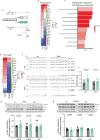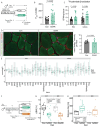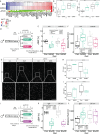This is a preprint.
Sulfur Amino Acid Restriction Enhances Exercise Capacity in Mice by Boosting Fat Oxidation in Muscle
- PMID: 39005372
- PMCID: PMC11244859
- DOI: 10.1101/2024.06.27.601041
Sulfur Amino Acid Restriction Enhances Exercise Capacity in Mice by Boosting Fat Oxidation in Muscle
Abstract
Dietary restriction of the sulfur-containing amino acids methionine and cysteine (SAAR) improves body composition, enhances insulin sensitivity, and extends lifespan; benefits seen also with endurance exercise. Yet, the impact of SAAR on skeletal muscle remains largely unexplored. Here we demonstrate that one week of SAAR in sedentary, young, male mice increases endurance exercise capacity. Indirect calorimetry showed that SAAR increased lipid oxidation at rest and delayed the onset of carbohydrate utilization during exercise. Transcriptomic analysis revealed increased expression of genes involved in fatty acid catabolism especially in glycolytic muscle following SAAR. These findings were functionally supported by increased fatty acid circulatory turnover flux and muscle β-oxidation. Reducing lipid uptake from circulation through endothelial cell (EC)-specific CD36 deletion attenuated the running phenotype. Mechanistically, VEGF-signaling inhibition prevented exercise increases following SAAR, without affecting angiogenesis, implicating noncanonical VEGF signaling and EC CD36-dependent fatty acid transport in regulating exercise capacity by influencing muscle substrate availability.
Conflict of interest statement
Declaration Of Interests The authors declare no competing interests.
Figures





Similar articles
-
Physical activity of mice on dietary sulfur amino acid restriction is influenced by age of diet initiation and biological sex.Sci Rep. 2023 Nov 23;13(1):20609. doi: 10.1038/s41598-023-47676-7. Sci Rep. 2023. PMID: 37996548 Free PMC article.
-
Cysteine restriction-specific effects of sulfur amino acid restriction on lipid metabolism.Aging Cell. 2022 Dec;21(12):e13739. doi: 10.1111/acel.13739. Epub 2022 Nov 19. Aging Cell. 2022. PMID: 36403077 Free PMC article.
-
Differential Effects of Sulfur Amino Acid-Restricted and Low-Calorie Diets on Gut Microbiome Profile and Bile Acid Composition in Male C57BL6/J Mice.J Gerontol A Biol Sci Med Sci. 2021 Oct 13;76(11):1922-1929. doi: 10.1093/gerona/glaa270. J Gerontol A Biol Sci Med Sci. 2021. PMID: 33106871 Free PMC article.
-
Disease prevention and delayed aging by dietary sulfur amino acid restriction: translational implications.Ann N Y Acad Sci. 2018 Apr;1418(1):44-55. doi: 10.1111/nyas.13584. Epub 2018 Feb 5. Ann N Y Acad Sci. 2018. PMID: 29399808 Review.
-
Regulation of fat metabolism in skeletal muscle.Ann N Y Acad Sci. 2002 Jun;967:217-35. doi: 10.1111/j.1749-6632.2002.tb04278.x. Ann N Y Acad Sci. 2002. PMID: 12079850 Review.
References
-
- Abcouwer S.F., Marjon P.L., Loper R.K., Vander Jagt D.L., 2002. Response of VEGF expression to amino acid deprivation and inducers of endoplasmic reticulum stress. Invest. Ophthalmol. Vis. Sci. 43, 2791–2798. - PubMed
-
- Agius T., Emsley R., Lyon A., MacArthur M.R., Kiesworo K., Faivre A., Stavart L., Lambelet M., Legouis D., De Seigneux S., Golshayan D., Lazeyras F., Yeh H., Markmann J.F., Uygun K., Ocampo A., Mitchell S.J., Allagnat F., Déglise S., Longchamp A., 2024. Short-term hypercaloric carbohydrate loading increases surgical stress resilience by inducing FGF21. Nat. Commun. 15, 1073. 10.1038/s41467-024-44866-3 - DOI - PMC - PubMed
-
- Arany Z., Foo S.-Y., Ma Y., Ruas J.L., Bommi-Reddy A., Girnun G., Cooper M., Laznik D., Chinsomboon J., Rangwala S.M., Baek K.H., Rosenzweig A., Spiegelman B.M., 2008. HIF-independent regulation of VEGF and angiogenesis by the transcriptional coactivator PGC-1α. Nature 451, 1008–1012. 10.1038/nature06613 - DOI - PubMed
Publication types
Grants and funding
LinkOut - more resources
Full Text Sources
